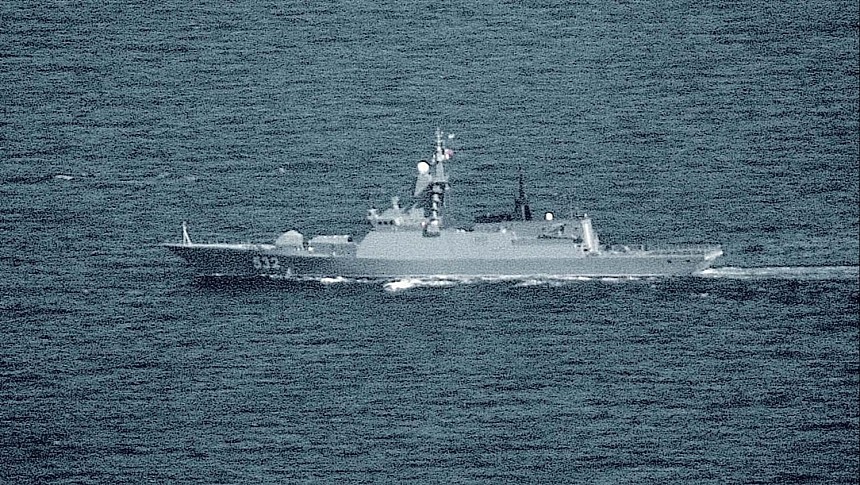Waters around the UK were the location of an impressive display of force recently. In times of peace, it would have been a treat to see so many elite warships and aircraft in close proximity to each other. But this was no friendly exercise. Royal Navy ships and patrol aircraft worked together to keep a close eye on Russian vessels transiting this area.
Last year, around the same time, three Type 23 frigates shadowed a Russian task group that had departed from the Eastern Mediterranean on its way back to the motherland. The shadowing mission kicked into gear after the Marshal Ustinov cruiser had suddenly left the area where it had remained stationary for nearly half a year.
Two American destroyers were the first to start following it. When the Russian ships reached the Strait of Gibraltar and then the Celtic Sea, three Royal Navy frigates (HMS Westminster, HMS Lancaster, and HMS Richmond) took over the monitoring task.
This year, HMS Tyne and HMS Portland played the same part. The old Marshal Ustinov was the common denominator. A Slava-class ship, Marshal Ustinov is the sister ship of Moskva, Russia's flagship that was infamously destroyed in April 2022. Commissioned in 1982, Ustinov carries modern weapons (Vulcan anti-ship missiles) and is still a powerful enemy.
This time, Ustinov was accompanied by the Udaloy-class destroyer Severomorsk and two corvettes (Boikyi and Grad), among other vessels. The two Royal Navy warships kept a close eye on them, following their movement in the English Channel, North Sea, and North Atlantic, with help from the sky.
These types of ships are designed to work together with the Royal Air Force's long-range patrol aircraft. The high-precision Poseidon quickly detects enemy ships or submarines and then sends all the information to the frigates. Once they receive the data with the exact location, ships are ready to intercept and track the enemy.
This is what took place during this recent monitoring mission. With ships and aircraft working together, the Royal Navy could ensure constant surveillance of the Russian vessels.
The P8 Poseidon aircraft that participated in the surveillance operation were part of the RAF Lossiemouth-based fleet. Officially a maritime patrol aircraft, Poseidon is fitted with top-notch acoustic sensor systems and radars for high-resolution mapping. It packs five powerful torpedoes and can fly at 490 knots (564 mph/907 kph). It's based on the Boeing 737/800, made in the US. Unlike its American counterpart, it uses a Mk 54 lightweight torpedo instead of the Sting Ray, which is the Royal Navy's standard lightweight torpedo.
While the P8 Poseidon is part of the Navy's new generation of submarine hunters, the Type 23 frigates will be replaced soon by the Type 26 state-of-the-art warships.
Two American destroyers were the first to start following it. When the Russian ships reached the Strait of Gibraltar and then the Celtic Sea, three Royal Navy frigates (HMS Westminster, HMS Lancaster, and HMS Richmond) took over the monitoring task.
This year, HMS Tyne and HMS Portland played the same part. The old Marshal Ustinov was the common denominator. A Slava-class ship, Marshal Ustinov is the sister ship of Moskva, Russia's flagship that was infamously destroyed in April 2022. Commissioned in 1982, Ustinov carries modern weapons (Vulcan anti-ship missiles) and is still a powerful enemy.
This time, Ustinov was accompanied by the Udaloy-class destroyer Severomorsk and two corvettes (Boikyi and Grad), among other vessels. The two Royal Navy warships kept a close eye on them, following their movement in the English Channel, North Sea, and North Atlantic, with help from the sky.
These types of ships are designed to work together with the Royal Air Force's long-range patrol aircraft. The high-precision Poseidon quickly detects enemy ships or submarines and then sends all the information to the frigates. Once they receive the data with the exact location, ships are ready to intercept and track the enemy.
This is what took place during this recent monitoring mission. With ships and aircraft working together, the Royal Navy could ensure constant surveillance of the Russian vessels.
The P8 Poseidon aircraft that participated in the surveillance operation were part of the RAF Lossiemouth-based fleet. Officially a maritime patrol aircraft, Poseidon is fitted with top-notch acoustic sensor systems and radars for high-resolution mapping. It packs five powerful torpedoes and can fly at 490 knots (564 mph/907 kph). It's based on the Boeing 737/800, made in the US. Unlike its American counterpart, it uses a Mk 54 lightweight torpedo instead of the Sting Ray, which is the Royal Navy's standard lightweight torpedo.
While the P8 Poseidon is part of the Navy's new generation of submarine hunters, the Type 23 frigates will be replaced soon by the Type 26 state-of-the-art warships.








